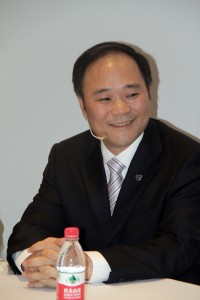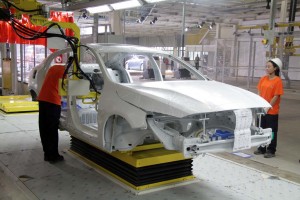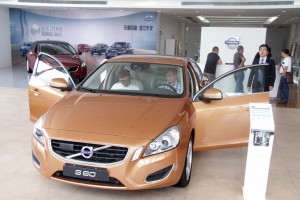The assembly line creeps along at a glacial pace. For the next few months, the workers at the sprawling plant on the outskirts of the Sichuanese capital of Chengdu will be carefully trained before the first cars actually roll into Chinese showrooms.
But eventually, if all goes according to plan, the factory will be running at a frantic rate. Long little more than an after-thought in the global luxury market, Volvo Cars has ambitions to challenge more established brands like Audi, BMW and Mercedes-Benz.
At least, that’s the goal set by Geely which purchased the Swedish maker from Ford Motor Co. three years ago. The ambitious Chinese conglomerate plans to invest at least $6 billion to rebuild Volvo, completely updating its product line-up and adding new plants to produce them, starting with the factory in Chengdu and another in China’s Northeast industrial belt.

Geely Chairman Li Shufu started out on a farm and now is one of the leaders of China's domestic auto industry.
“Volvo is a dream brand for me,” explains Chinese tycoon Li Shufu, who began life on a subsistence farm and eventually wound up creating one of the Asian nation’s most successful domestic auto brands, Geely. Li had long been stymied in his efforts to turn Geely into a global brand, prompting his decision to buy Volvo in 2010.
With its traditional focus on Scandinavian design and advanced safety technology, Volvo is one of the auto industry’s most familiar brand names, but sales have lagged far behind its recognition factor. And when Ford decided it no longer wanted to prop up the struggling Swedish maker, more than a few analysts wondered whether it would go the same way as cross-country rival, Saab, which was declared insolvent in December 2011.
Certainly, Volvo had its problems. Sales have sharply declined in recent years, plunging 6% in 2012, to just 421,951. In its key market, the United States, volume dipped by nearly a third from its prior peak of around 100,000. As a result, the maker has been steadily bleeding cash even as it has begun a $6 billion capital investment campaign.
For his part, Li insists he will stick with that ambitious program with a goal of boosting global sales to 800,000 before the end of the decade. The plan is to reach 100,000 in the States. So the big opportunity – some would say challenge – will be China, where Volvo now plans to reach 200,000 sales which would make the Asian nation its biggest global market.
That would still fall short of competitors like Mercedes and BMW, acknowledges Hakan Samuelsson, the Swedish maker’s CEO, as he walks the floor of the new Chengdu plant, “But you don’t need to be the biggest in the world to be the most profitable.”
While the two new Chinese plants will give Volvo the ability to meet its admittedly ambitious sales goals, the real challenge will be coming up with the new products that consumers – whether in China, the U.S. or Europe – want.
The first model to roll out of the Chengdu facility will be a stretch version of the current S60 line, dubbed the S60L and targeting a new generation of upscale Chinese consumers who prefer to be chauffeured rather than fight the endemic traffic in cities like Shanghai and Beijing.
But at the Frankfurt Motor Show later this year, Volvo will offer a more revealing glimpse of its future, an all-new model that will be the first to use a flexible architecture – or platform, if you prefer – that will eventually be used for a wide range of sedans, wagons and crossovers, and possibly for some future coupes and convertibles, as well.
The so-called CMA architecture will be followed by a second platform that will be used for smaller Volvo models, such as the V40 wagon.
Meanwhile, the maker is also gearing up to introduce an all-new engine. In a risky diversion from standard luxury practice, Volvo will abandon its current V-6 and V-8 powertrains; instead, it plans to power all future models with a high-mileage four-cylinder engine. For higher-performance models it will use turbos or even hybrid-electric technology that, Samuelsson explains, can be tuned to deliver both fuel economy and power, as needed.
The maker recently launched its first hybrid model, a diesel plug-in, in Europe. It hopes to have a gasoline version of that offering in the critical American market in the next few years.
While China is soon likely to overtake the U.S. in terms of sales before decade’s end – at least if Chairman Li has his way, the American market could regain its lead further out. Samuelsson admits he would still like to add a North American plant, possibly in the South or the Southeast where other European makers have set up assembly lines.
Can Geely help Volvo pull off its revival plan?
“The awareness of the Volvo brand is high” in China, says Michael Dunne, a long-time automotive analyst based in Asia. And there’s a growing interest in safety in a market that now has as many highway fatalities as the U.S.
For his part, analyst Dave Sullivan, of AutoPacific, Inc., is a little more skeptical. He cautions that most of Volvo’s competitors now emphasize safety, as well. The new 2014 Mercedes-Benz E-Class, for example, has a dizzying array of technology that all but allows the vehicle to drive itself.
Nonetheless, Sullivan says “There’s a lot of potential in the brand, and if anyone has the money to fund Volvo’s turnaround, it’s Geely.”
The test will come as production slowly ramps up on the Chengdu assembly line.
This story first appeared on NBCNews.com.





SIx billion is a good 1-2 year program for a small operation but it’s going to take a whole lot more cash and time to ramp Volvo, especially in China with a completely new untrained work force.
What works in China is far different than the rest of the world. I don’t see the Volvo brand surviving unless they offer a low price and something special to create sales. Safety alone simply isn’t enough nor is high mpg.